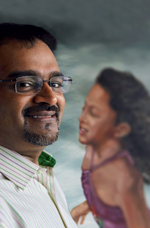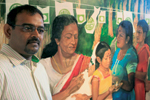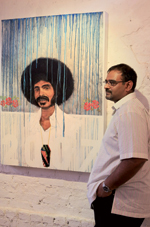The Edge, 27 August 2008
Cover story: Strokes of Life
Good storytellers are truly a rare and marvellous lot. We can all remember instances of being spellbound by masterful raconteurs who have left us with deep impression of the encounters that even with the passage of time, the memory of them lingers. They captured our imaginations, aroused in us a spectrum of emotions and perhaps even inspired us to be better than who we are — all through the seemingly simple act of telling a tale.
Anurendra Jegadeva is one such storyteller, but not in the way you’d expect. He doesn’t tell his stories verbally or through the written word, but through one of the most ancient forms of storytelling — with pictures.
The 43-year-old of Sri Lankan Tamil descent is one of the foremost narrative artists in Malaysia who forged a name for himself as a painter and profiler of Malaysian Indians. His first solo exhibition, titled First Works, was shown at the Australian High Commission in 1993, and since then, he has participated in numerous solo and group exhibitions in Malaysia and Australia to critical acclaim.
I met him at the Wei-Ling Gallery in Brickfields one sunny afternoon, where his solo exhibition, Conditional Love: Painted Stories, is on display. “Call me Anu,” he says, as he extends his hand in a firm handshake. His round, pleasant face sports an easygoing smile, and his friendly and personable demeanour makes me feel completely at ease. His eagerness to show me his works and tell me all about them is charmingly childlike, and when he suggests a walk around, I readily agree.
At a casual glance, the 24 works on canvas and paper seem disparate from one another. There are lyrical depictions of brides with grotesque vampire teeth set against barren landscapes, an Indian priest holding a broken Ganesha head, portraits of Indian men and women in various settings or none at all, and one of the late Loga Arumugam of the Alleycats. Rich in symbolism, the paintings’ message was not immediately apparent to me, as they seem to speak of a thousand things at once.
Anu uses the example of a Chinese altar to explain the correlation of the paintings. “In a Chinese altar, there’s a central deity, and around it are all the things that serve it, from the oranges to the cup with the candle and the incense holder, all of which are complementary. They’re all quite separate things, but they all come together. And that’s what the paintings are like. There are all these things that come together to find a way to work with each other.”
In Anu’s case, the “central deity” of his new body of work is love. He explains that he started with the idea of painting love stories and that emotion is explored in its various forms and interpretations. A self-professed TV addict, Anu draws extensively from popular culture as well as current events in the nation and globally. “I think it’s a world gone mad everywhere,” he says. “There’s so much happening now and the media is always throwing things at you. That kind of sensory overload was what I wanted this exhibition to be like, almost like surfing channels. But the starting point is always myself — it’s me responding to it; it’s my dialogue with the news.”
His way of trying to understand it all — though he’s quick to point out that he doesn’t have any answers — is by putting it into the form of stories and translating them onto canvas. “My process is stories — larger stories that relate to all of us as people within the context of where we live, but told in a very autobiographical voice. That’s the only way I can make sense of it,” says Anu, adding that the tales he weaves into his paintings are often very personal in nature, stemming from his reflections on life and from his family.
One work, The Secret of Life, has his parents facing each other, with arrows pointing to both of them and a cockatoo on a heart above them. It is his way of depicting the notion of compromise. He elaborates, “My mum had a cockatoo, but my father hated the bird. I just used him as a starting point but this is very much a commentary on Indian middle class families in Malaysia. I’ve just used my parents as bouncing balls, but in their personal lives, in their traditions within the community and in their place in the nation as well, it’s always been about compromise.”
While some stories are personal in nature, others are things he concocts that surround a particular issue. In Playful Priests, he tackles the issue of Indian temples being destroyed, but rather than looking at the temples, he looks at the priests. “So what do these priests do now? Do they go on holidays on AirAsia?” he asks amusingly. “I make up these scenarios in my head, and the stories I spin are often ridiculous, but they are starting points. I think it’s a way of tricking people into thinking about an issue.”
In two startlingly poignant pieces, Conditional 1 and Conditional 2, one sees a side profile of Datuk Seri Wan Azizah Wan Ismail looking askance at an FRU guard, who’s painted on a separate canvas. On the surface, it seems to be a commentary on what this woman has had to go through, but Anu says the focus is not so much the political side of things. “I think this is the greatest love story of our generation. Really, 10 years of this going on and on? But I didn’t want to make this about (Datuk Seri) Anwar (Ibrahim). I put the FRU guard here and looking away because I didn’t want the whole idea of oppressor and victimiser, but of how his role is quite unconditional as well, as far as she’s concerned. It’s a very confusing time for us, and I wanted to capture that confusion here, to juxtapose the two,” he says.
“It was the only thing I did reasonably well from the time I was young,” Anu says deprecatingly, when I ask when he knew he wanted to be painter. His grandmother was a painter and spending time with her while growing up had an influence on him. But it was Datuk Ibrahim Hussein’s Retrospective exhibition at the National Gallery which he viewed in secondary school that clinched it. He was so taken by those works, and that’s when he knew he wanted to be a painter, “just like Ibrahim”.
At a time when a career in art was not the most lucrative or promising, Anu found it simply amazing that his traditional Indian parents allowed him to go to art school at Oxford Polytechnic in London and paid his way through. He says, “Though they were traditional in every sense, they were really forward-thinking in that way. And it was never easy for them. There were times where I didn’t want to be in art school anymore, didn’t see the point in it and all of that. They actually went through a lot of trouble for me to find my way,” he relates.
When he returned to Malaysia in the late 80s, the local art scene, though thriving, was still very much in its nascent stage. The landscape hadn’t developed enough to the point where it could sustain individuals who wanted to be full-time artists. A general lack of awareness prevailed among the masses when it came to Malaysian art, which translated to a lack of support for artists and their works. Anu points to the inadequate profiling of Malaysian artists as one of the main culprits.
Hence, artists during that time had to have day jobs to sustain themselves, while their artistic pursuits took a back seat. Anu taught art at his alma mater, Methodist College, upon his return and painted on the side. But he soon enrolled himself to do law part-time through University of London’s external programme. “I was an artist with no money. How was I going to get married?” he laughs. “Which respectable Indian family would allow their daughter to be married to someone like me? It was all those issues, and also sustaining a living as an artist.”
After obtaining his law degree, he continued to teach and paint, but then decided to apply for a job at The Star where his cousin, Eddin Khoo, was working as a journalist and who was having the time of his life “meeting the most exciting people and travelling”. He got the job, and Anu spent 10 years at the daily writing features on food and art, taking off for a year to concentrate on painting but then going back because he missed it all. “It was a fantastic platform for me,” he says of his years as a journalist. “The exposure I got working in a newspaper for 10 years couldn’t have been replaced.”
While Anu could only afford to be a part-time artist in his earlier years, today that situation is changing. “Now the market allows artists to be full-time artists,” he says. “There’s much higher awareness, which comes with the fact that art is a much bigger commodity than it was before, as an asset and as currency.”
The commodification of Malaysian art, spurred on by the boom in Asian contemporary art on a larger global scale, has been instrumental in raising the profile of local artists and their works. Anu sees it as a major factor that is driving the local art movement and even creativity. There is now more of an incentive to create where very little existed before. “If you look at poor countries, there’s no incentive for artists. If they do [create], often it is tourist art. But if you want art to be made seriously, you have to have the infrastructure to support it and part of it is money.
“Now that there’s interest in art as a commodity rather than just a cultural product, institutions like Galeri Petronas and Balai Lukis Seni Negara have woken up, and we are adapting to the new situation. We also now have more private and commercial galleries than ever before, stemming also from a rise in more knowledgeable and interested collectors. I think it’s very exciting. I don’t think the issue has ever been that there are no exciting artists here — they just haven’t been supported enough and that’s why it’s been difficult,” says the obviously elated Anu.
In 1999, Anu’s wife was offered a job in Melbourne, Australia, and the family decided to relocate there. Anu enrolled at Monash University and did his studio masters, staying on after that to join the faculty and work as a curator for the university gallery. The life they led in Melbourne was a good one — they lived in a house they owned in a nice part of the city and the people they met were open and welcoming. But there seemed always to be something missing, Anu recalls — a feeling of disconnect somehow.
“It just happened incrementally. At first to go away and study while my wife worked was fine, but then you realise you’ve been there for seven years, and suddenly the prospect of never coming home was just hard to come to terms with. Every time we came back for a break and went back, rather than getting easier, it got more difficult,” shares Anu, adding that the emotional connection to KL and Malaysia was a bond that did not weaken by distance or the passing of time.
“It’s not so much family or anything, as they come to visit all the time, but a sense of place. I think a sense of place is very important because all the stories that are important to me are only relevant here as an artist,” he explains.
His works during that time were certainly reflective of where his heart and soul truly lay. One series of paintings he did in Australia that was exhibited here was entirely on rice cookers and food. “The rice cooker is really a migrant deity. It was always placed in the hall, and eating became the central thing for migrants because that is a slice of home. That feeling never went away for us.” And so in 2005, the family packed up and moved back to KL.
Anu currently works as senior curator for Galeri Petronas, an institution he holds in high esteem. “It’s everyone’s dream really to work in a gallery of that stature,” he gushes. “As an artist, it’s fantastic to be a part of this organisation and part of a team which has built the gallery to the point it was at but now is ready to take it to another level. We’ve really done that. Tengku Nasariah [Syed Ibrahim], our director, has really pushed for that over the last two years. It’s been fantastic.”
And just like before, even with his full-time position at Galeri Petronas, he paints as well. Conditional Love: Painted Stories is his first solo exhibition since his return from Australia and is a series that took him a year to develop. How does his current works compare to his earlier ones, I ask.
“I have a style that was developed 20 years ago, and it’s very tied in to 20 years ago. It’s just developed like that,” he says, as he gestures a straight line. “I’m very much in my infancy in many ways. I’ve always done other things, so I don’t have a huge body of work. But the things I make I’m serious about, and I think I have a very important body of work.”
He continues, “I haven’t done that much work, but this is the time for me to be doing that work because I’ve reached a level of maturity now in my thinking process. If you ask me where or how I have changed, of course as a painter, you can’t help for things to develop incrementally. The scale of the paintings has evolved and they’re much more ambitious, but it’s not like I’ve moved from being a painter to an installation artist — I’m still very much interested in painting. Whatever other mediums that interest me, they’re always in the context of a very classical approach to painting. But it’s in the telling of the story, the use of symbols, that are a lot more succinct and clever than they were.”
He adds that while many are quick to criticise the censorship imposed on local artists, he sees it as an avenue for a more ingenious form of creative expression. “It’s not like we can’t do things, but we have to do things in a different way, to go around it. Now that, I think, is the strength of Malaysian art. Often we are forced to have to think inventively, and that process of how I tell the story has become for me much more mature than ever before.”
Every one of us has individuals in our lives who in one way or another were instrumental in helping us come to where we are today. When I field that question to Anu, he contemplates for a moment. “This is a very dangerous question; I hope I don’t leave anyone out,” he says, half jokingly. “Ibrahim Hussein, though I don’t know him well enough, has been a sort of yardstick, and I love his work. There have been people in galleries, such as Valentine [Willie] and Beverly [Yong, both of Valentine Willie Fine Art] who really encouraged me when I first started out — they played a really integral role.
“When I stopped painting for a while, Datuk N Parameswaran, the Malaysian High Commissioner to Singapore, forced me to start painting again. He used to organise exhibitions and he loved my old works and he wanted me to be in those shows. You need encouragement like that. People like [Lim] Wei Ling, this gallery, have been really instrumental. Even though I’ve only been here for a year, it’s been fantastic. From a teaching point of view, there are two people: Redza Piyadasa and Jolly Koh. Both have been a considerable influence and had a hand in my development.”
On the homefront, the artist has a nine-year-old daughter who is artistically inclined, just like her father. Anu says his wife and daughter are the best judges of his work — they are often critical, but always right in the end. “Most of the time, they’re pretty spot on. Everything from aesthetics to philosophy and content-wise, they’re very good judges of what I want to say.”
Anu doesn’t have anything planned yet for his next solo exhibition but is currently concentrating on making works for group shows. In the midst of all this, he finds time to indulge in his favourite pastime — watching television. “TV is such a wonderful reference point. I waste a lot of time watching it, but all this has come out of that,” he says, referring to his artworks. “I know everything on Nickelodeon. In fact, the kids’ channel is much better than what we’re getting on adult TV.” He starts naming shows he enjoys, such as SpongeBob SquarePants, Cow and Chicken, Fairly Odd Parents and Samurai Jack. “I find that language quite beautiful, to be able to appeal to adults and children at the same time. My work is like that — there’s a childlike storytelling quality to it that I really cherish.”
It is this very same quality that resonates with both art lovers and critics, because no matter how old we get, we’ll never tire of a good story.
Conditional Love: Painted Stories is on exhibit until Sept 4 at Wei-Ling Gallery, 8 Jalan Scott, Brickfields, KL. Call (03) 2260 1106/7 or visit www.weiling-gallery.com for more information.



